
A SAS/IML programmer asked whether you can pass the name of a function as an argument to a SAS/IML module and have the module call the function that is passed in. The answer is "yes." The basic idea is to create a string that represents the function call and then








